Managing Finance Report: Ratio Analysis, Costing and Acquisition
VerifiedAdded on 2023/01/17
|12
|2516
|66
Report
AI Summary
This report analyzes the financial performance of two companies, Jones Ltd and Millet Ltd, using various financial ratios such as operating profit ratio, return on equity, inventory turnover, and others. It discusses the performance of each company based on these ratios, recommending the acquisition of...
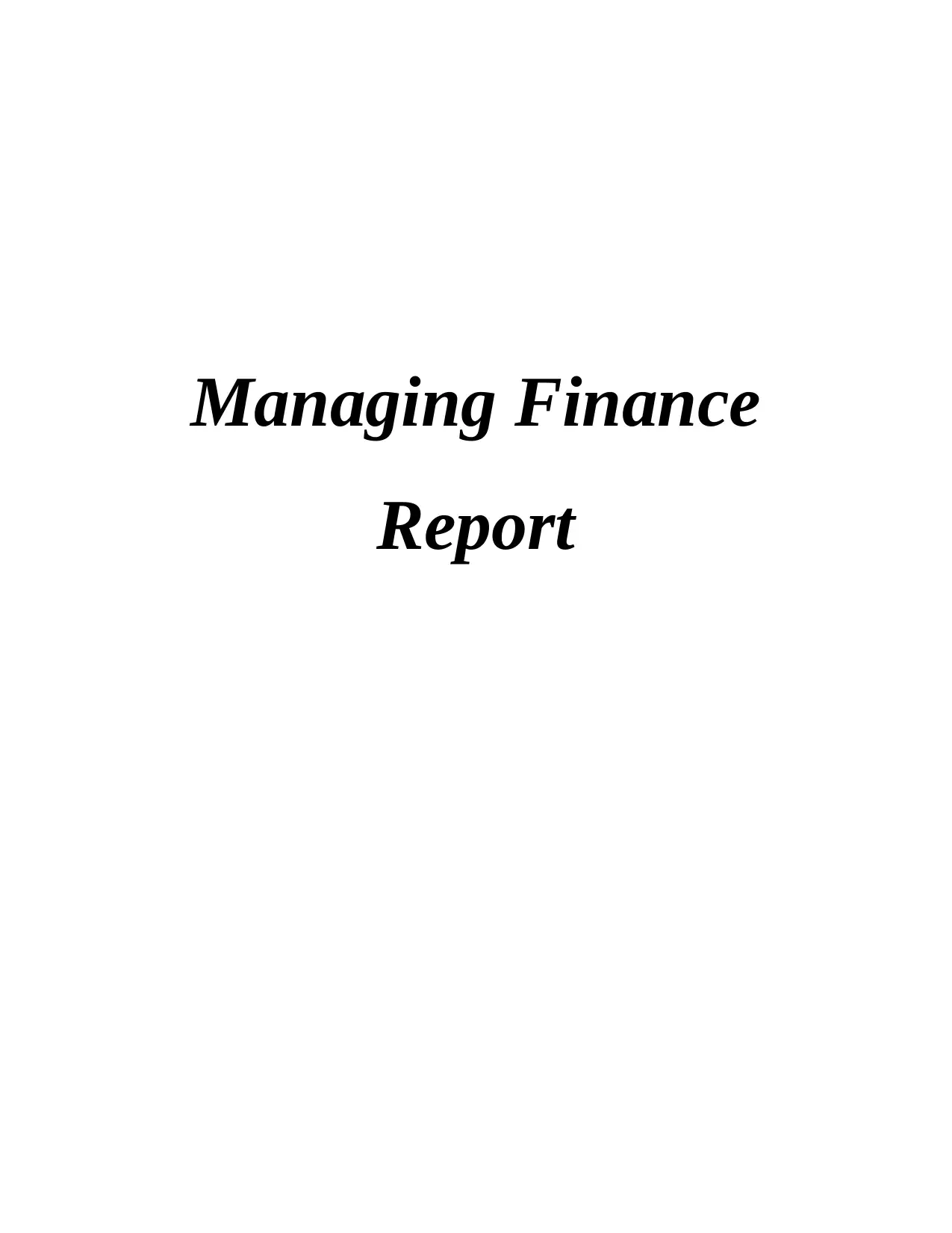
Managing Finance
Report
Report
Paraphrase This Document
Need a fresh take? Get an instant paraphrase of this document with our AI Paraphraser

Table of Contents
INTRODUCTION...........................................................................................................................1
MAIN BODY...................................................................................................................................1
Calculations of ratios of targeted companies...............................................................................1
Discussion of performance of the companies..............................................................................4
Recommendations for the acquisition..........................................................................................4
Critical assessment of limitation of financial ratios in decision making of business organisation
......................................................................................................................................................5
Classification of costs and indication of the basis of classification.............................................5
Preparation of job cost statement.................................................................................................7
Provision of an advice on the acceptability of the order..............................................................8
CONCLUSION................................................................................................................................8
REFERENCES................................................................................................................................9
INTRODUCTION...........................................................................................................................1
MAIN BODY...................................................................................................................................1
Calculations of ratios of targeted companies...............................................................................1
Discussion of performance of the companies..............................................................................4
Recommendations for the acquisition..........................................................................................4
Critical assessment of limitation of financial ratios in decision making of business organisation
......................................................................................................................................................5
Classification of costs and indication of the basis of classification.............................................5
Preparation of job cost statement.................................................................................................7
Provision of an advice on the acceptability of the order..............................................................8
CONCLUSION................................................................................................................................8
REFERENCES................................................................................................................................9
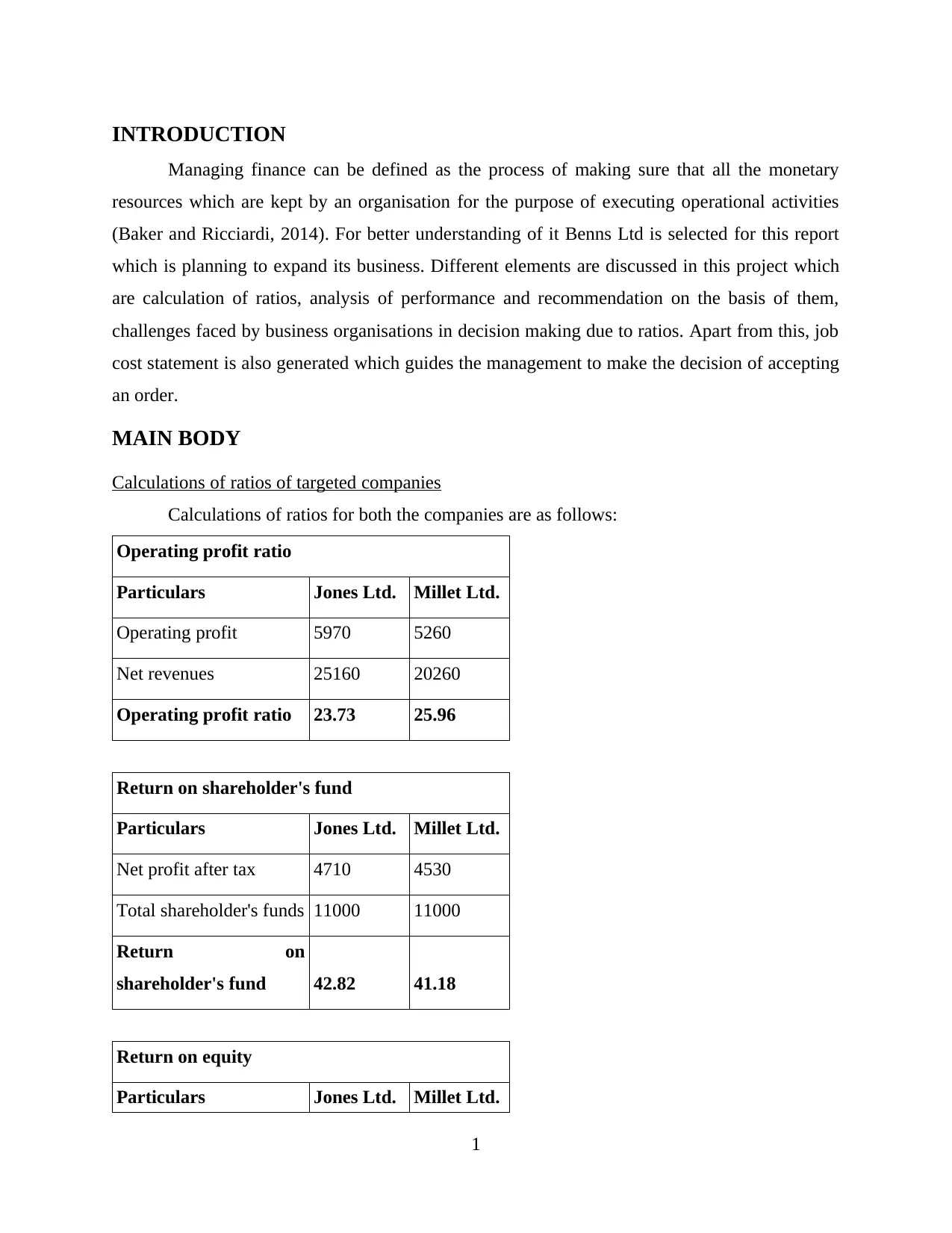
INTRODUCTION
Managing finance can be defined as the process of making sure that all the monetary
resources which are kept by an organisation for the purpose of executing operational activities
(Baker and Ricciardi, 2014). For better understanding of it Benns Ltd is selected for this report
which is planning to expand its business. Different elements are discussed in this project which
are calculation of ratios, analysis of performance and recommendation on the basis of them,
challenges faced by business organisations in decision making due to ratios. Apart from this, job
cost statement is also generated which guides the management to make the decision of accepting
an order.
MAIN BODY
Calculations of ratios of targeted companies
Calculations of ratios for both the companies are as follows:
Operating profit ratio
Particulars Jones Ltd. Millet Ltd.
Operating profit 5970 5260
Net revenues 25160 20260
Operating profit ratio 23.73 25.96
Return on shareholder's fund
Particulars Jones Ltd. Millet Ltd.
Net profit after tax 4710 4530
Total shareholder's funds 11000 11000
Return on
shareholder's fund 42.82 41.18
Return on equity
Particulars Jones Ltd. Millet Ltd.
1
Managing finance can be defined as the process of making sure that all the monetary
resources which are kept by an organisation for the purpose of executing operational activities
(Baker and Ricciardi, 2014). For better understanding of it Benns Ltd is selected for this report
which is planning to expand its business. Different elements are discussed in this project which
are calculation of ratios, analysis of performance and recommendation on the basis of them,
challenges faced by business organisations in decision making due to ratios. Apart from this, job
cost statement is also generated which guides the management to make the decision of accepting
an order.
MAIN BODY
Calculations of ratios of targeted companies
Calculations of ratios for both the companies are as follows:
Operating profit ratio
Particulars Jones Ltd. Millet Ltd.
Operating profit 5970 5260
Net revenues 25160 20260
Operating profit ratio 23.73 25.96
Return on shareholder's fund
Particulars Jones Ltd. Millet Ltd.
Net profit after tax 4710 4530
Total shareholder's funds 11000 11000
Return on
shareholder's fund 42.82 41.18
Return on equity
Particulars Jones Ltd. Millet Ltd.
1
⊘ This is a preview!⊘
Do you want full access?
Subscribe today to unlock all pages.

Trusted by 1+ million students worldwide
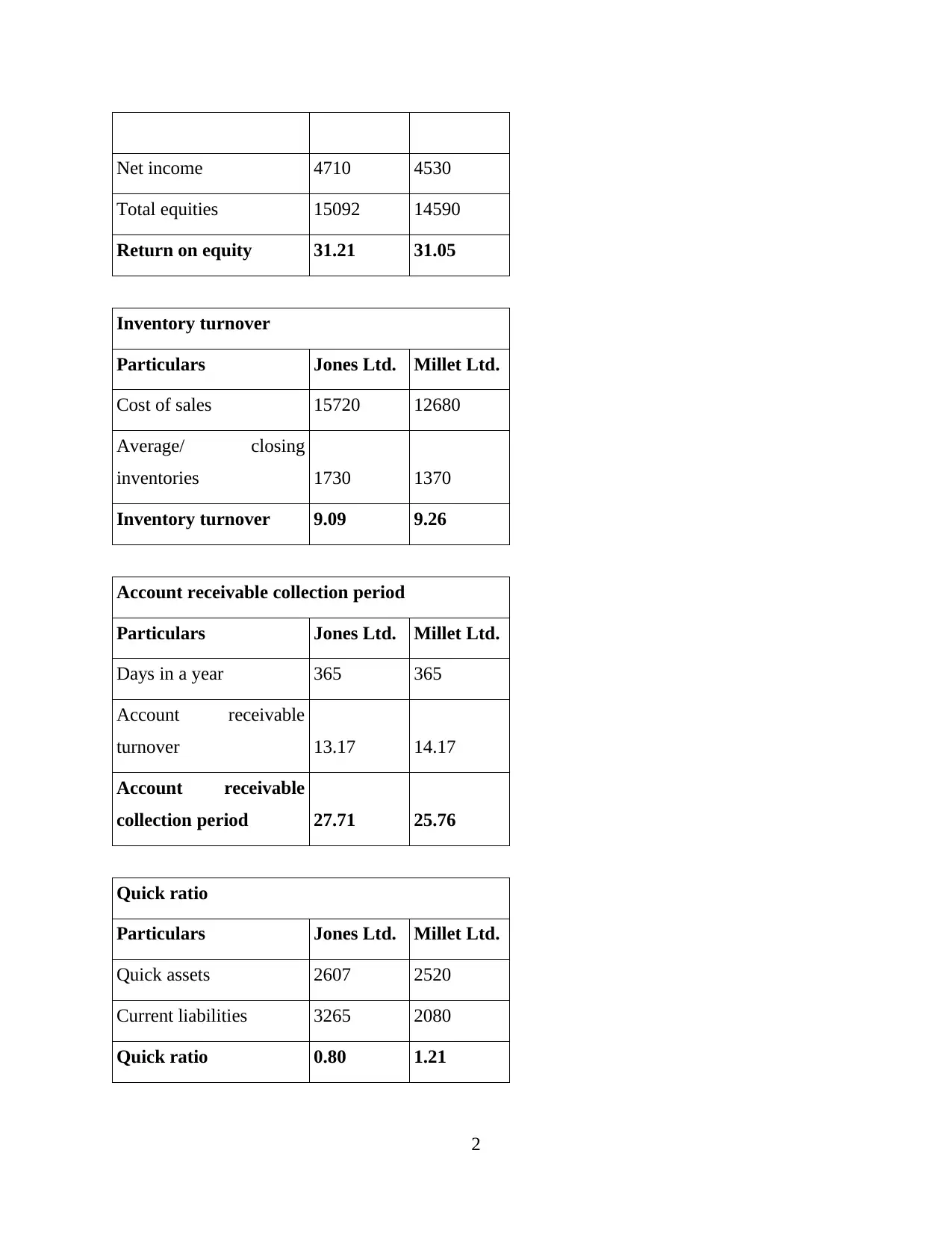
Net income 4710 4530
Total equities 15092 14590
Return on equity 31.21 31.05
Inventory turnover
Particulars Jones Ltd. Millet Ltd.
Cost of sales 15720 12680
Average/ closing
inventories 1730 1370
Inventory turnover 9.09 9.26
Account receivable collection period
Particulars Jones Ltd. Millet Ltd.
Days in a year 365 365
Account receivable
turnover 13.17 14.17
Account receivable
collection period 27.71 25.76
Quick ratio
Particulars Jones Ltd. Millet Ltd.
Quick assets 2607 2520
Current liabilities 3265 2080
Quick ratio 0.80 1.21
2
Total equities 15092 14590
Return on equity 31.21 31.05
Inventory turnover
Particulars Jones Ltd. Millet Ltd.
Cost of sales 15720 12680
Average/ closing
inventories 1730 1370
Inventory turnover 9.09 9.26
Account receivable collection period
Particulars Jones Ltd. Millet Ltd.
Days in a year 365 365
Account receivable
turnover 13.17 14.17
Account receivable
collection period 27.71 25.76
Quick ratio
Particulars Jones Ltd. Millet Ltd.
Quick assets 2607 2520
Current liabilities 3265 2080
Quick ratio 0.80 1.21
2
Paraphrase This Document
Need a fresh take? Get an instant paraphrase of this document with our AI Paraphraser
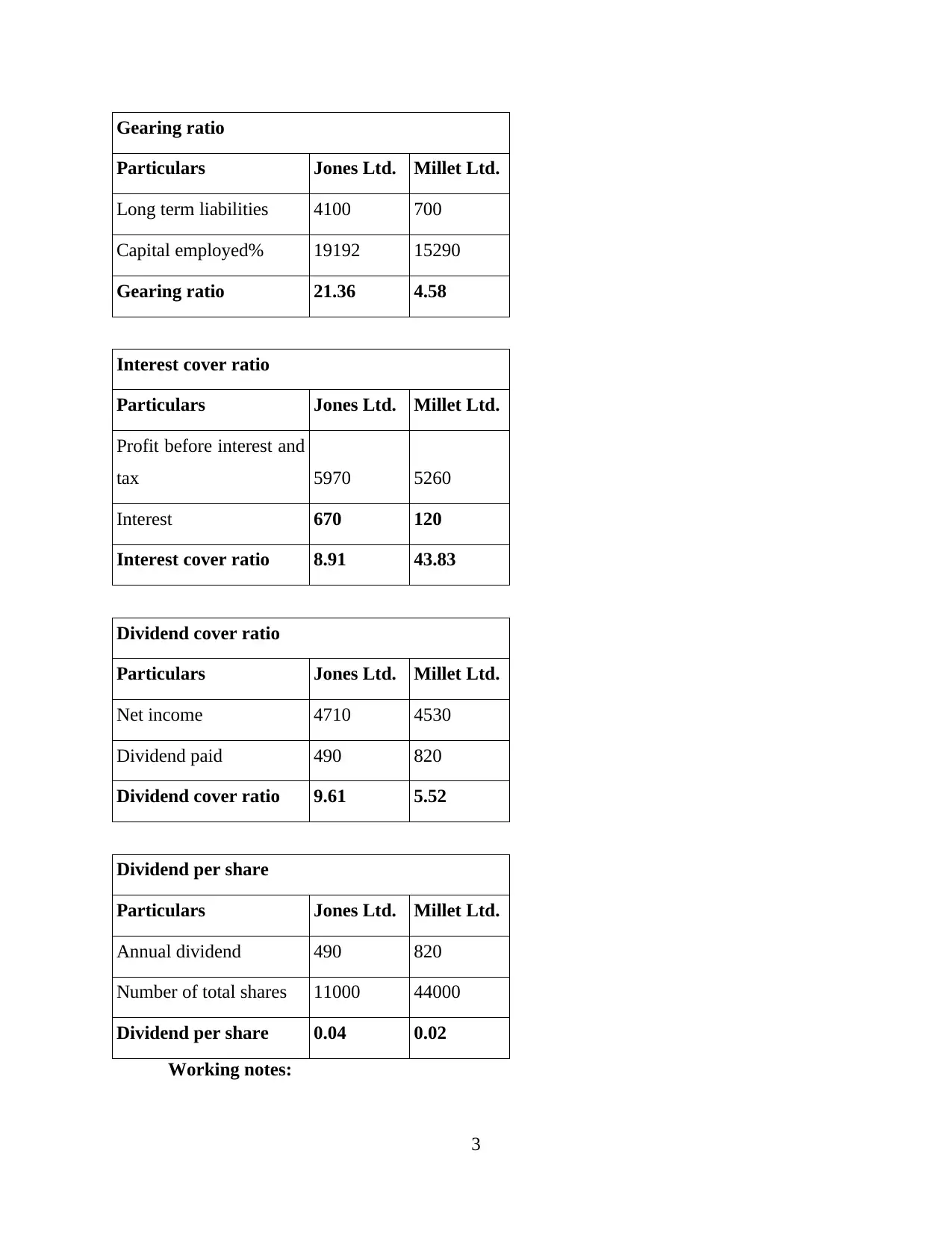
Gearing ratio
Particulars Jones Ltd. Millet Ltd.
Long term liabilities 4100 700
Capital employed% 19192 15290
Gearing ratio 21.36 4.58
Interest cover ratio
Particulars Jones Ltd. Millet Ltd.
Profit before interest and
tax 5970 5260
Interest 670 120
Interest cover ratio 8.91 43.83
Dividend cover ratio
Particulars Jones Ltd. Millet Ltd.
Net income 4710 4530
Dividend paid 490 820
Dividend cover ratio 9.61 5.52
Dividend per share
Particulars Jones Ltd. Millet Ltd.
Annual dividend 490 820
Number of total shares 11000 44000
Dividend per share 0.04 0.02
Working notes:
3
Particulars Jones Ltd. Millet Ltd.
Long term liabilities 4100 700
Capital employed% 19192 15290
Gearing ratio 21.36 4.58
Interest cover ratio
Particulars Jones Ltd. Millet Ltd.
Profit before interest and
tax 5970 5260
Interest 670 120
Interest cover ratio 8.91 43.83
Dividend cover ratio
Particulars Jones Ltd. Millet Ltd.
Net income 4710 4530
Dividend paid 490 820
Dividend cover ratio 9.61 5.52
Dividend per share
Particulars Jones Ltd. Millet Ltd.
Annual dividend 490 820
Number of total shares 11000 44000
Dividend per share 0.04 0.02
Working notes:
3
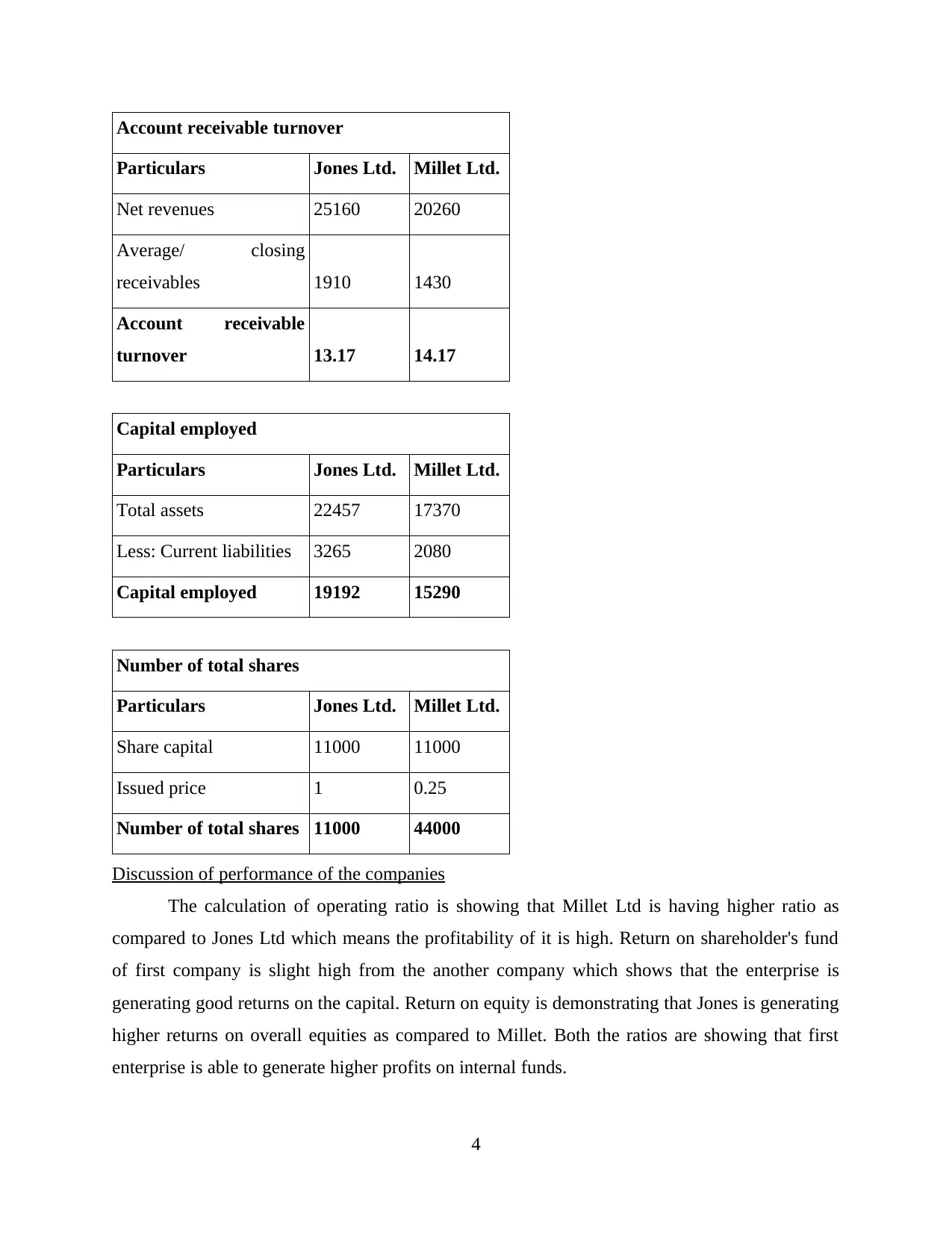
Account receivable turnover
Particulars Jones Ltd. Millet Ltd.
Net revenues 25160 20260
Average/ closing
receivables 1910 1430
Account receivable
turnover 13.17 14.17
Capital employed
Particulars Jones Ltd. Millet Ltd.
Total assets 22457 17370
Less: Current liabilities 3265 2080
Capital employed 19192 15290
Number of total shares
Particulars Jones Ltd. Millet Ltd.
Share capital 11000 11000
Issued price 1 0.25
Number of total shares 11000 44000
Discussion of performance of the companies
The calculation of operating ratio is showing that Millet Ltd is having higher ratio as
compared to Jones Ltd which means the profitability of it is high. Return on shareholder's fund
of first company is slight high from the another company which shows that the enterprise is
generating good returns on the capital. Return on equity is demonstrating that Jones is generating
higher returns on overall equities as compared to Millet. Both the ratios are showing that first
enterprise is able to generate higher profits on internal funds.
4
Particulars Jones Ltd. Millet Ltd.
Net revenues 25160 20260
Average/ closing
receivables 1910 1430
Account receivable
turnover 13.17 14.17
Capital employed
Particulars Jones Ltd. Millet Ltd.
Total assets 22457 17370
Less: Current liabilities 3265 2080
Capital employed 19192 15290
Number of total shares
Particulars Jones Ltd. Millet Ltd.
Share capital 11000 11000
Issued price 1 0.25
Number of total shares 11000 44000
Discussion of performance of the companies
The calculation of operating ratio is showing that Millet Ltd is having higher ratio as
compared to Jones Ltd which means the profitability of it is high. Return on shareholder's fund
of first company is slight high from the another company which shows that the enterprise is
generating good returns on the capital. Return on equity is demonstrating that Jones is generating
higher returns on overall equities as compared to Millet. Both the ratios are showing that first
enterprise is able to generate higher profits on internal funds.
4
⊘ This is a preview!⊘
Do you want full access?
Subscribe today to unlock all pages.

Trusted by 1+ million students worldwide
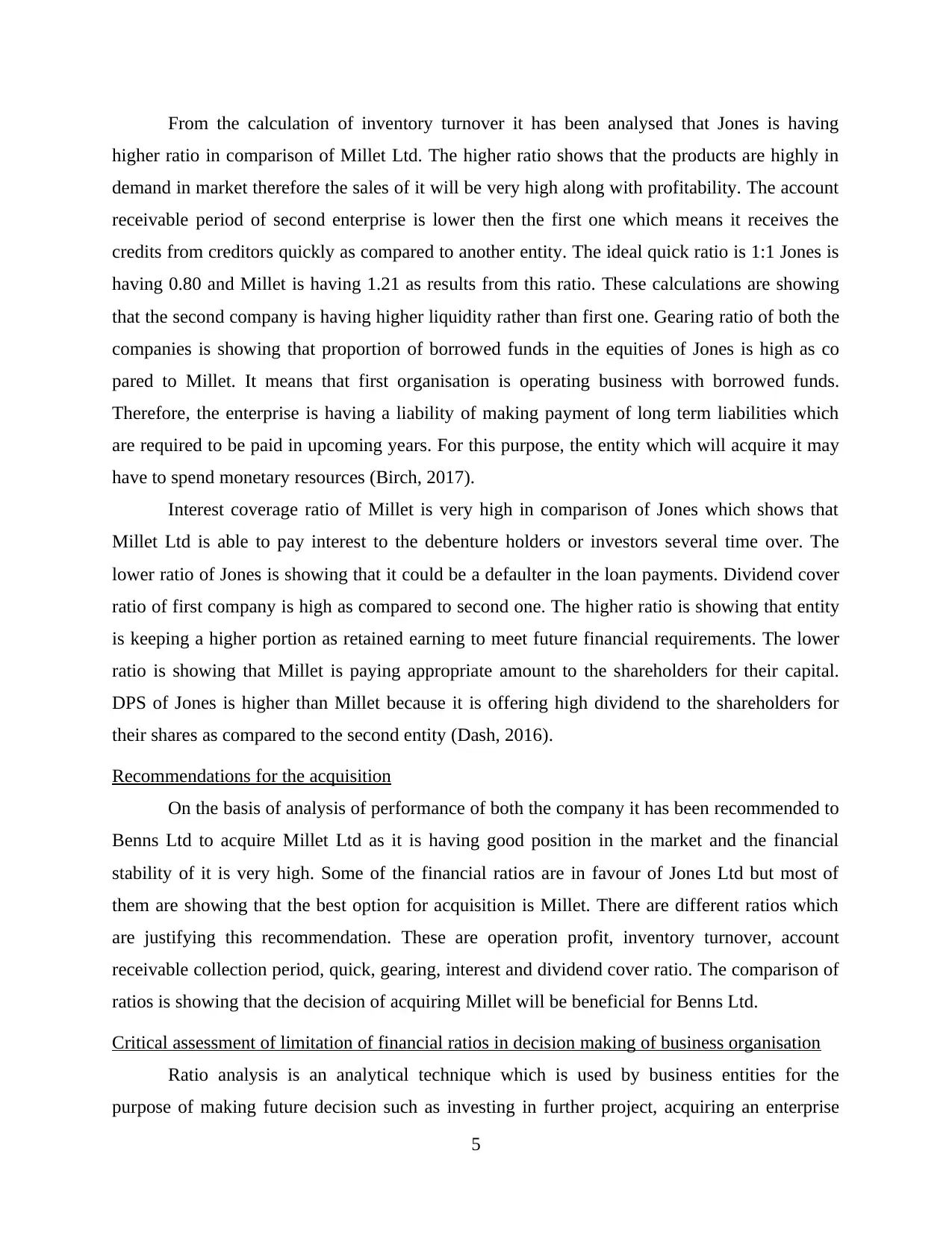
From the calculation of inventory turnover it has been analysed that Jones is having
higher ratio in comparison of Millet Ltd. The higher ratio shows that the products are highly in
demand in market therefore the sales of it will be very high along with profitability. The account
receivable period of second enterprise is lower then the first one which means it receives the
credits from creditors quickly as compared to another entity. The ideal quick ratio is 1:1 Jones is
having 0.80 and Millet is having 1.21 as results from this ratio. These calculations are showing
that the second company is having higher liquidity rather than first one. Gearing ratio of both the
companies is showing that proportion of borrowed funds in the equities of Jones is high as co
pared to Millet. It means that first organisation is operating business with borrowed funds.
Therefore, the enterprise is having a liability of making payment of long term liabilities which
are required to be paid in upcoming years. For this purpose, the entity which will acquire it may
have to spend monetary resources (Birch, 2017).
Interest coverage ratio of Millet is very high in comparison of Jones which shows that
Millet Ltd is able to pay interest to the debenture holders or investors several time over. The
lower ratio of Jones is showing that it could be a defaulter in the loan payments. Dividend cover
ratio of first company is high as compared to second one. The higher ratio is showing that entity
is keeping a higher portion as retained earning to meet future financial requirements. The lower
ratio is showing that Millet is paying appropriate amount to the shareholders for their capital.
DPS of Jones is higher than Millet because it is offering high dividend to the shareholders for
their shares as compared to the second entity (Dash, 2016).
Recommendations for the acquisition
On the basis of analysis of performance of both the company it has been recommended to
Benns Ltd to acquire Millet Ltd as it is having good position in the market and the financial
stability of it is very high. Some of the financial ratios are in favour of Jones Ltd but most of
them are showing that the best option for acquisition is Millet. There are different ratios which
are justifying this recommendation. These are operation profit, inventory turnover, account
receivable collection period, quick, gearing, interest and dividend cover ratio. The comparison of
ratios is showing that the decision of acquiring Millet will be beneficial for Benns Ltd.
Critical assessment of limitation of financial ratios in decision making of business organisation
Ratio analysis is an analytical technique which is used by business entities for the
purpose of making future decision such as investing in further project, acquiring an enterprise
5
higher ratio in comparison of Millet Ltd. The higher ratio shows that the products are highly in
demand in market therefore the sales of it will be very high along with profitability. The account
receivable period of second enterprise is lower then the first one which means it receives the
credits from creditors quickly as compared to another entity. The ideal quick ratio is 1:1 Jones is
having 0.80 and Millet is having 1.21 as results from this ratio. These calculations are showing
that the second company is having higher liquidity rather than first one. Gearing ratio of both the
companies is showing that proportion of borrowed funds in the equities of Jones is high as co
pared to Millet. It means that first organisation is operating business with borrowed funds.
Therefore, the enterprise is having a liability of making payment of long term liabilities which
are required to be paid in upcoming years. For this purpose, the entity which will acquire it may
have to spend monetary resources (Birch, 2017).
Interest coverage ratio of Millet is very high in comparison of Jones which shows that
Millet Ltd is able to pay interest to the debenture holders or investors several time over. The
lower ratio of Jones is showing that it could be a defaulter in the loan payments. Dividend cover
ratio of first company is high as compared to second one. The higher ratio is showing that entity
is keeping a higher portion as retained earning to meet future financial requirements. The lower
ratio is showing that Millet is paying appropriate amount to the shareholders for their capital.
DPS of Jones is higher than Millet because it is offering high dividend to the shareholders for
their shares as compared to the second entity (Dash, 2016).
Recommendations for the acquisition
On the basis of analysis of performance of both the company it has been recommended to
Benns Ltd to acquire Millet Ltd as it is having good position in the market and the financial
stability of it is very high. Some of the financial ratios are in favour of Jones Ltd but most of
them are showing that the best option for acquisition is Millet. There are different ratios which
are justifying this recommendation. These are operation profit, inventory turnover, account
receivable collection period, quick, gearing, interest and dividend cover ratio. The comparison of
ratios is showing that the decision of acquiring Millet will be beneficial for Benns Ltd.
Critical assessment of limitation of financial ratios in decision making of business organisation
Ratio analysis is an analytical technique which is used by business entities for the
purpose of making future decision such as investing in further project, acquiring an enterprise
5
Paraphrase This Document
Need a fresh take? Get an instant paraphrase of this document with our AI Paraphraser
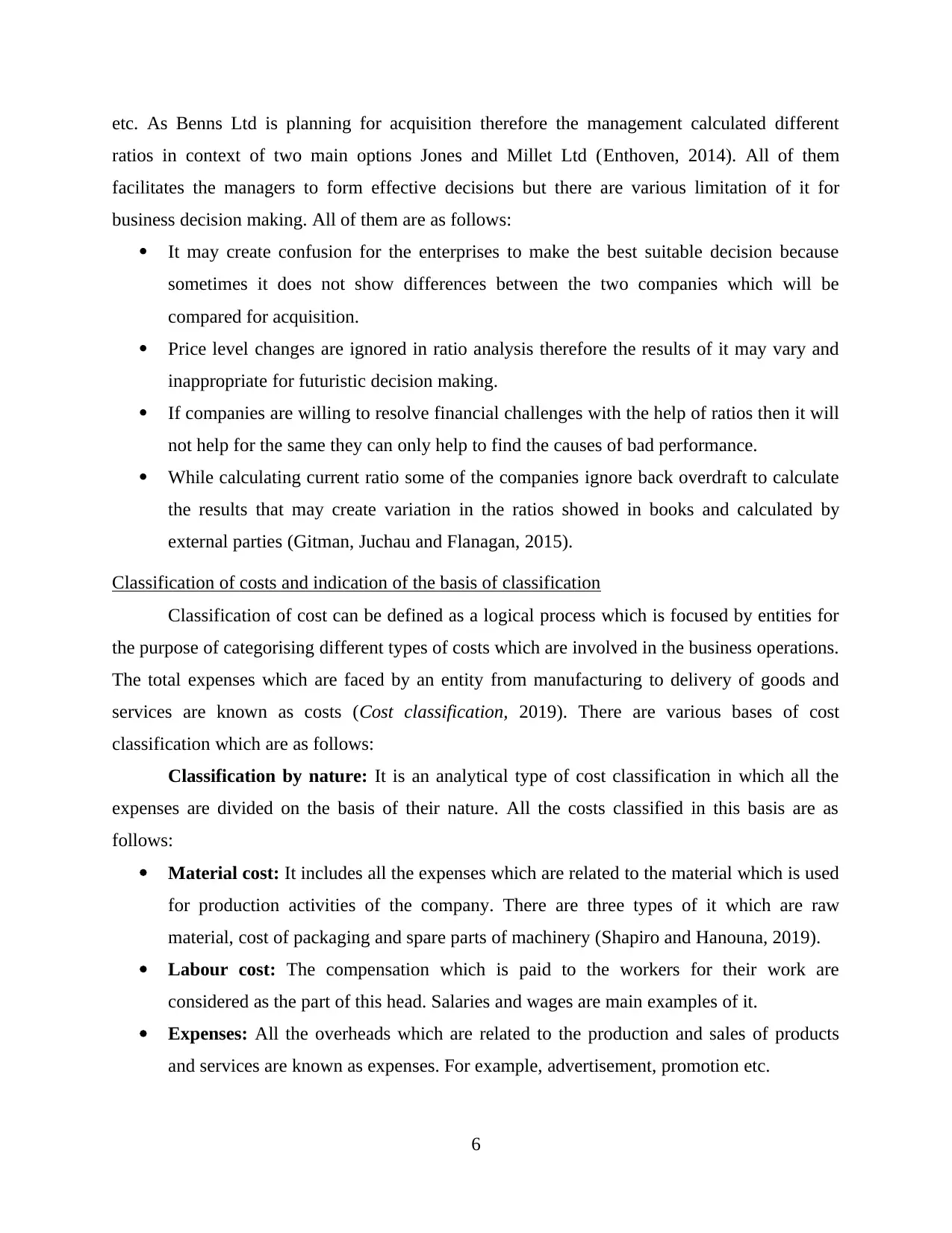
etc. As Benns Ltd is planning for acquisition therefore the management calculated different
ratios in context of two main options Jones and Millet Ltd (Enthoven, 2014). All of them
facilitates the managers to form effective decisions but there are various limitation of it for
business decision making. All of them are as follows:
It may create confusion for the enterprises to make the best suitable decision because
sometimes it does not show differences between the two companies which will be
compared for acquisition.
Price level changes are ignored in ratio analysis therefore the results of it may vary and
inappropriate for futuristic decision making.
If companies are willing to resolve financial challenges with the help of ratios then it will
not help for the same they can only help to find the causes of bad performance.
While calculating current ratio some of the companies ignore back overdraft to calculate
the results that may create variation in the ratios showed in books and calculated by
external parties (Gitman, Juchau and Flanagan, 2015).
Classification of costs and indication of the basis of classification
Classification of cost can be defined as a logical process which is focused by entities for
the purpose of categorising different types of costs which are involved in the business operations.
The total expenses which are faced by an entity from manufacturing to delivery of goods and
services are known as costs (Cost classification, 2019). There are various bases of cost
classification which are as follows:
Classification by nature: It is an analytical type of cost classification in which all the
expenses are divided on the basis of their nature. All the costs classified in this basis are as
follows:
Material cost: It includes all the expenses which are related to the material which is used
for production activities of the company. There are three types of it which are raw
material, cost of packaging and spare parts of machinery (Shapiro and Hanouna, 2019).
Labour cost: The compensation which is paid to the workers for their work are
considered as the part of this head. Salaries and wages are main examples of it.
Expenses: All the overheads which are related to the production and sales of products
and services are known as expenses. For example, advertisement, promotion etc.
6
ratios in context of two main options Jones and Millet Ltd (Enthoven, 2014). All of them
facilitates the managers to form effective decisions but there are various limitation of it for
business decision making. All of them are as follows:
It may create confusion for the enterprises to make the best suitable decision because
sometimes it does not show differences between the two companies which will be
compared for acquisition.
Price level changes are ignored in ratio analysis therefore the results of it may vary and
inappropriate for futuristic decision making.
If companies are willing to resolve financial challenges with the help of ratios then it will
not help for the same they can only help to find the causes of bad performance.
While calculating current ratio some of the companies ignore back overdraft to calculate
the results that may create variation in the ratios showed in books and calculated by
external parties (Gitman, Juchau and Flanagan, 2015).
Classification of costs and indication of the basis of classification
Classification of cost can be defined as a logical process which is focused by entities for
the purpose of categorising different types of costs which are involved in the business operations.
The total expenses which are faced by an entity from manufacturing to delivery of goods and
services are known as costs (Cost classification, 2019). There are various bases of cost
classification which are as follows:
Classification by nature: It is an analytical type of cost classification in which all the
expenses are divided on the basis of their nature. All the costs classified in this basis are as
follows:
Material cost: It includes all the expenses which are related to the material which is used
for production activities of the company. There are three types of it which are raw
material, cost of packaging and spare parts of machinery (Shapiro and Hanouna, 2019).
Labour cost: The compensation which is paid to the workers for their work are
considered as the part of this head. Salaries and wages are main examples of it.
Expenses: All the overheads which are related to the production and sales of products
and services are known as expenses. For example, advertisement, promotion etc.
6
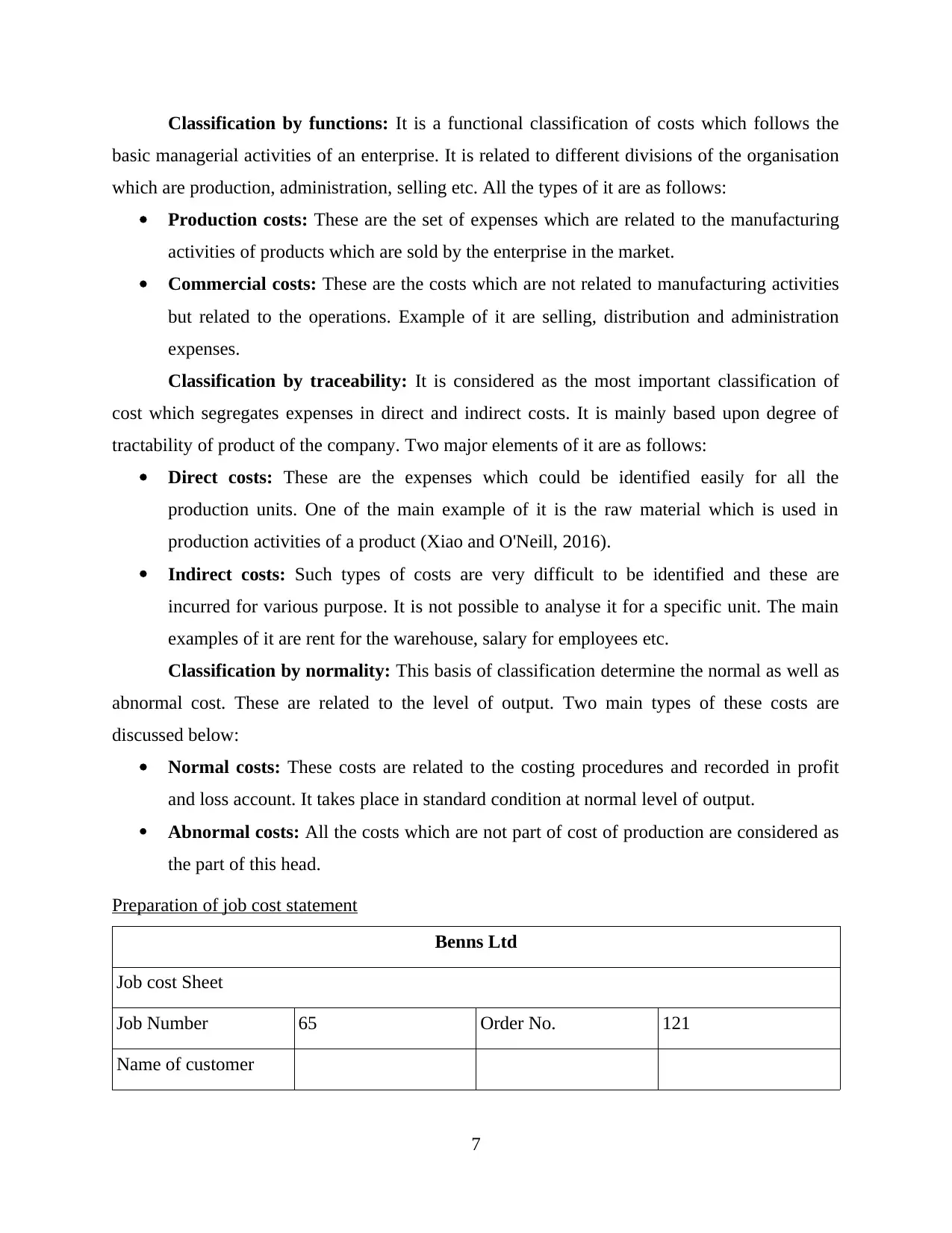
Classification by functions: It is a functional classification of costs which follows the
basic managerial activities of an enterprise. It is related to different divisions of the organisation
which are production, administration, selling etc. All the types of it are as follows:
Production costs: These are the set of expenses which are related to the manufacturing
activities of products which are sold by the enterprise in the market.
Commercial costs: These are the costs which are not related to manufacturing activities
but related to the operations. Example of it are selling, distribution and administration
expenses.
Classification by traceability: It is considered as the most important classification of
cost which segregates expenses in direct and indirect costs. It is mainly based upon degree of
tractability of product of the company. Two major elements of it are as follows:
Direct costs: These are the expenses which could be identified easily for all the
production units. One of the main example of it is the raw material which is used in
production activities of a product (Xiao and O'Neill, 2016).
Indirect costs: Such types of costs are very difficult to be identified and these are
incurred for various purpose. It is not possible to analyse it for a specific unit. The main
examples of it are rent for the warehouse, salary for employees etc.
Classification by normality: This basis of classification determine the normal as well as
abnormal cost. These are related to the level of output. Two main types of these costs are
discussed below:
Normal costs: These costs are related to the costing procedures and recorded in profit
and loss account. It takes place in standard condition at normal level of output.
Abnormal costs: All the costs which are not part of cost of production are considered as
the part of this head.
Preparation of job cost statement
Benns Ltd
Job cost Sheet
Job Number 65 Order No. 121
Name of customer
7
basic managerial activities of an enterprise. It is related to different divisions of the organisation
which are production, administration, selling etc. All the types of it are as follows:
Production costs: These are the set of expenses which are related to the manufacturing
activities of products which are sold by the enterprise in the market.
Commercial costs: These are the costs which are not related to manufacturing activities
but related to the operations. Example of it are selling, distribution and administration
expenses.
Classification by traceability: It is considered as the most important classification of
cost which segregates expenses in direct and indirect costs. It is mainly based upon degree of
tractability of product of the company. Two major elements of it are as follows:
Direct costs: These are the expenses which could be identified easily for all the
production units. One of the main example of it is the raw material which is used in
production activities of a product (Xiao and O'Neill, 2016).
Indirect costs: Such types of costs are very difficult to be identified and these are
incurred for various purpose. It is not possible to analyse it for a specific unit. The main
examples of it are rent for the warehouse, salary for employees etc.
Classification by normality: This basis of classification determine the normal as well as
abnormal cost. These are related to the level of output. Two main types of these costs are
discussed below:
Normal costs: These costs are related to the costing procedures and recorded in profit
and loss account. It takes place in standard condition at normal level of output.
Abnormal costs: All the costs which are not part of cost of production are considered as
the part of this head.
Preparation of job cost statement
Benns Ltd
Job cost Sheet
Job Number 65 Order No. 121
Name of customer
7
⊘ This is a preview!⊘
Do you want full access?
Subscribe today to unlock all pages.

Trusted by 1+ million students worldwide
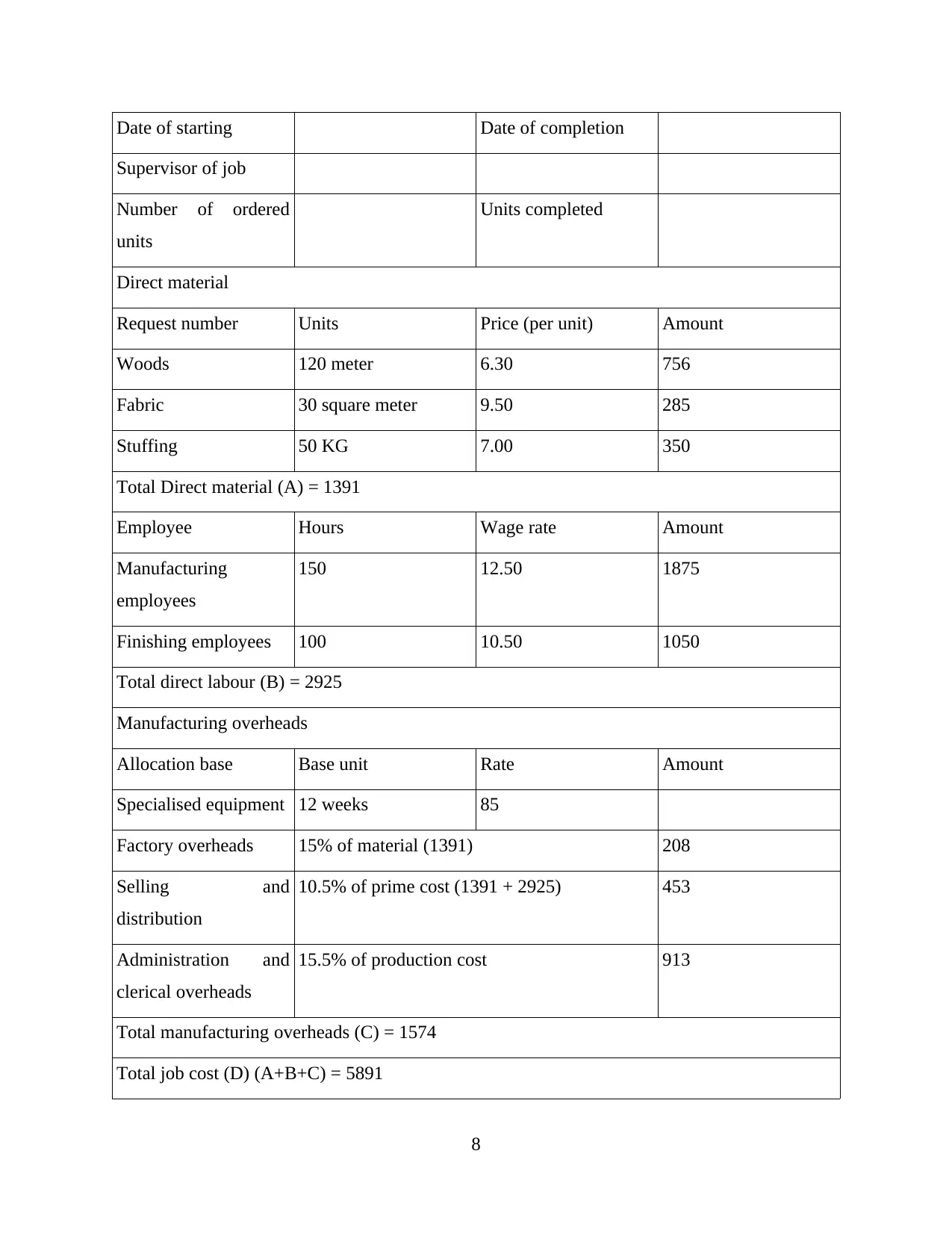
Date of starting Date of completion
Supervisor of job
Number of ordered
units
Units completed
Direct material
Request number Units Price (per unit) Amount
Woods 120 meter 6.30 756
Fabric 30 square meter 9.50 285
Stuffing 50 KG 7.00 350
Total Direct material (A) = 1391
Employee Hours Wage rate Amount
Manufacturing
employees
150 12.50 1875
Finishing employees 100 10.50 1050
Total direct labour (B) = 2925
Manufacturing overheads
Allocation base Base unit Rate Amount
Specialised equipment 12 weeks 85
Factory overheads 15% of material (1391) 208
Selling and
distribution
10.5% of prime cost (1391 + 2925) 453
Administration and
clerical overheads
15.5% of production cost 913
Total manufacturing overheads (C) = 1574
Total job cost (D) (A+B+C) = 5891
8
Supervisor of job
Number of ordered
units
Units completed
Direct material
Request number Units Price (per unit) Amount
Woods 120 meter 6.30 756
Fabric 30 square meter 9.50 285
Stuffing 50 KG 7.00 350
Total Direct material (A) = 1391
Employee Hours Wage rate Amount
Manufacturing
employees
150 12.50 1875
Finishing employees 100 10.50 1050
Total direct labour (B) = 2925
Manufacturing overheads
Allocation base Base unit Rate Amount
Specialised equipment 12 weeks 85
Factory overheads 15% of material (1391) 208
Selling and
distribution
10.5% of prime cost (1391 + 2925) 453
Administration and
clerical overheads
15.5% of production cost 913
Total manufacturing overheads (C) = 1574
Total job cost (D) (A+B+C) = 5891
8
Paraphrase This Document
Need a fresh take? Get an instant paraphrase of this document with our AI Paraphraser
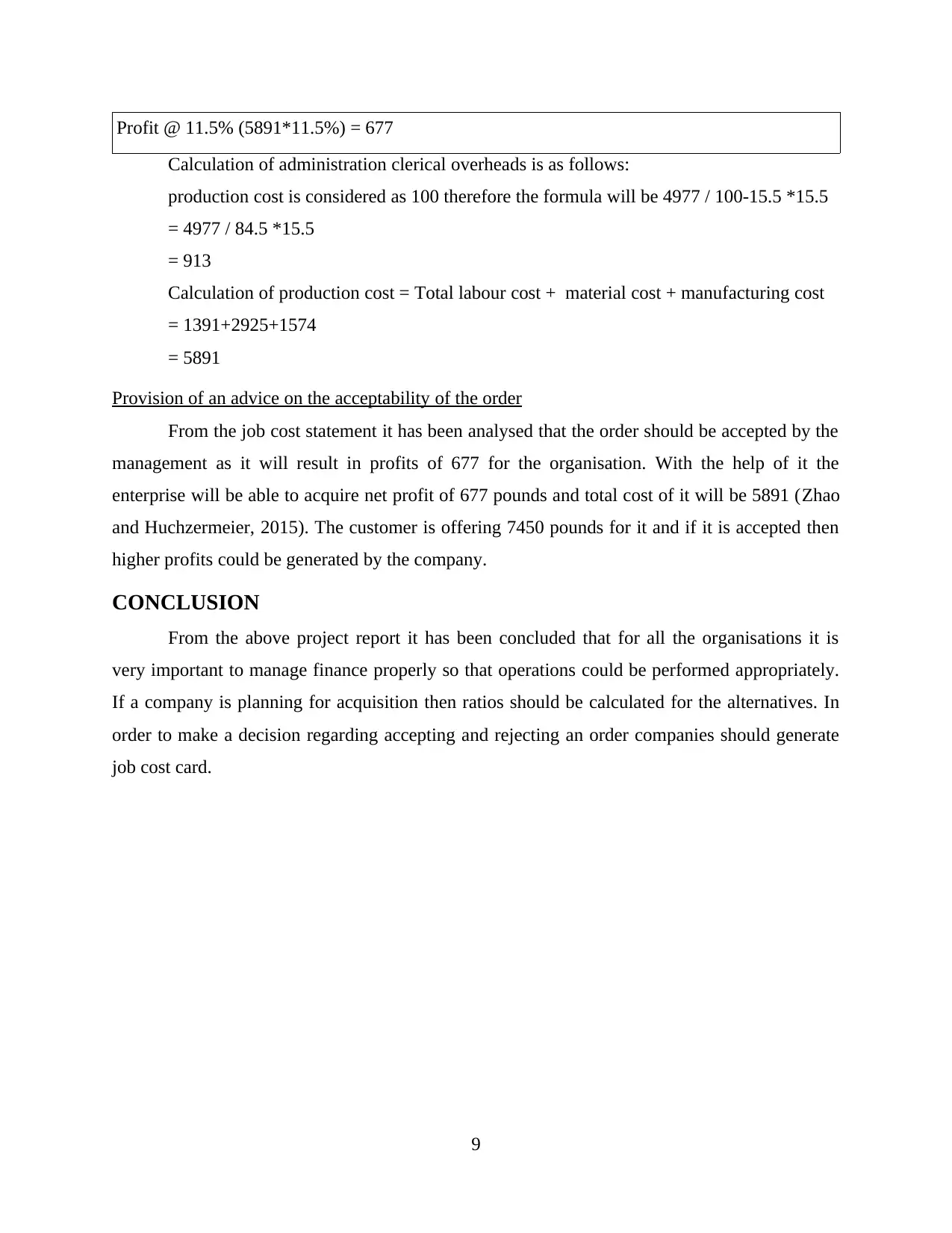
Profit @ 11.5% (5891*11.5%) = 677
Calculation of administration clerical overheads is as follows:
production cost is considered as 100 therefore the formula will be 4977 / 100-15.5 *15.5
= 4977 / 84.5 *15.5
= 913
Calculation of production cost = Total labour cost + material cost + manufacturing cost
= 1391+2925+1574
= 5891
Provision of an advice on the acceptability of the order
From the job cost statement it has been analysed that the order should be accepted by the
management as it will result in profits of 677 for the organisation. With the help of it the
enterprise will be able to acquire net profit of 677 pounds and total cost of it will be 5891 (Zhao
and Huchzermeier, 2015). The customer is offering 7450 pounds for it and if it is accepted then
higher profits could be generated by the company.
CONCLUSION
From the above project report it has been concluded that for all the organisations it is
very important to manage finance properly so that operations could be performed appropriately.
If a company is planning for acquisition then ratios should be calculated for the alternatives. In
order to make a decision regarding accepting and rejecting an order companies should generate
job cost card.
9
Calculation of administration clerical overheads is as follows:
production cost is considered as 100 therefore the formula will be 4977 / 100-15.5 *15.5
= 4977 / 84.5 *15.5
= 913
Calculation of production cost = Total labour cost + material cost + manufacturing cost
= 1391+2925+1574
= 5891
Provision of an advice on the acceptability of the order
From the job cost statement it has been analysed that the order should be accepted by the
management as it will result in profits of 677 for the organisation. With the help of it the
enterprise will be able to acquire net profit of 677 pounds and total cost of it will be 5891 (Zhao
and Huchzermeier, 2015). The customer is offering 7450 pounds for it and if it is accepted then
higher profits could be generated by the company.
CONCLUSION
From the above project report it has been concluded that for all the organisations it is
very important to manage finance properly so that operations could be performed appropriately.
If a company is planning for acquisition then ratios should be calculated for the alternatives. In
order to make a decision regarding accepting and rejecting an order companies should generate
job cost card.
9
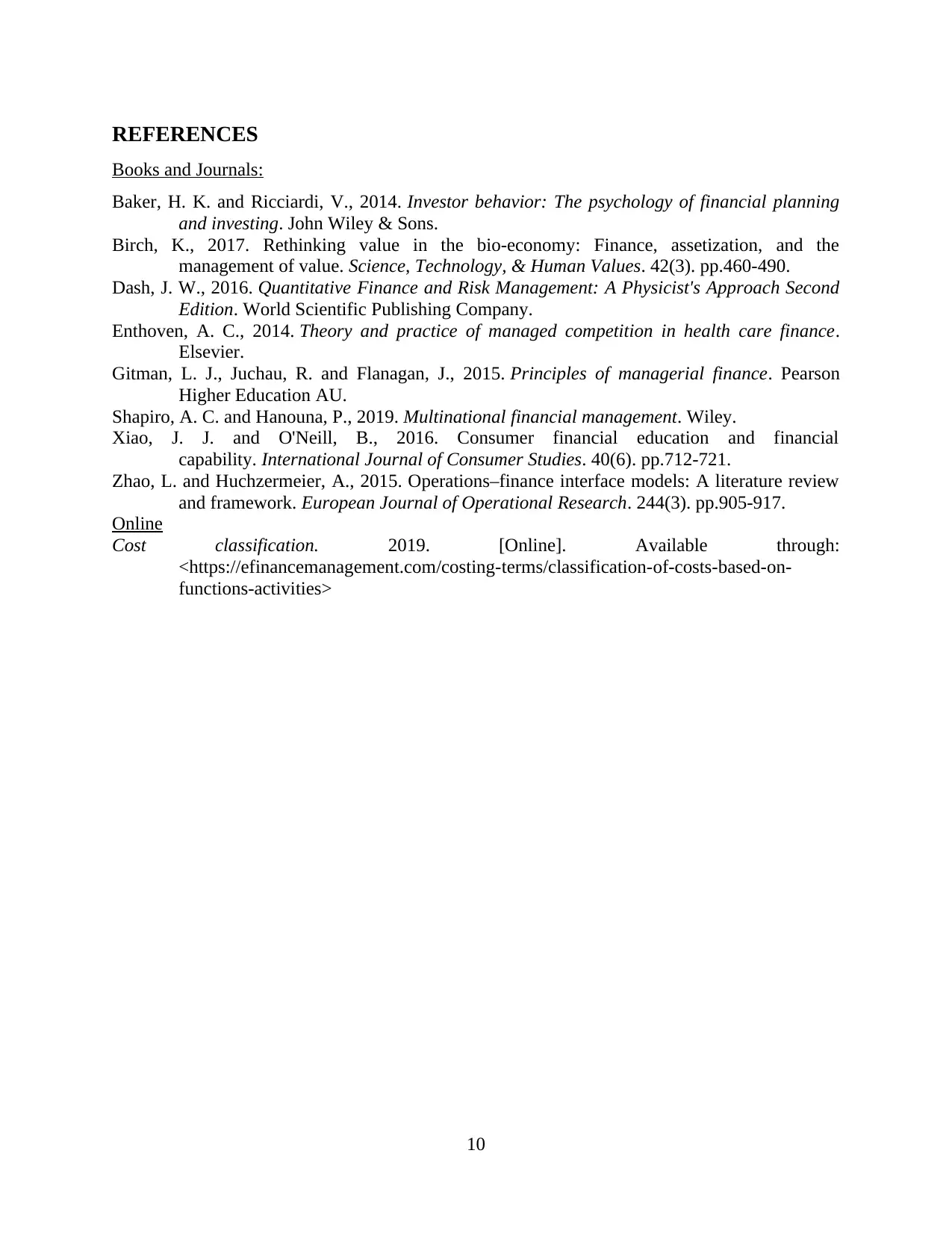
REFERENCES
Books and Journals:
Baker, H. K. and Ricciardi, V., 2014. Investor behavior: The psychology of financial planning
and investing. John Wiley & Sons.
Birch, K., 2017. Rethinking value in the bio-economy: Finance, assetization, and the
management of value. Science, Technology, & Human Values. 42(3). pp.460-490.
Dash, J. W., 2016. Quantitative Finance and Risk Management: A Physicist's Approach Second
Edition. World Scientific Publishing Company.
Enthoven, A. C., 2014. Theory and practice of managed competition in health care finance.
Elsevier.
Gitman, L. J., Juchau, R. and Flanagan, J., 2015. Principles of managerial finance. Pearson
Higher Education AU.
Shapiro, A. C. and Hanouna, P., 2019. Multinational financial management. Wiley.
Xiao, J. J. and O'Neill, B., 2016. Consumer financial education and financial
capability. International Journal of Consumer Studies. 40(6). pp.712-721.
Zhao, L. and Huchzermeier, A., 2015. Operations–finance interface models: A literature review
and framework. European Journal of Operational Research. 244(3). pp.905-917.
Online
Cost classification. 2019. [Online]. Available through:
<https://efinancemanagement.com/costing-terms/classification-of-costs-based-on-
functions-activities>
10
Books and Journals:
Baker, H. K. and Ricciardi, V., 2014. Investor behavior: The psychology of financial planning
and investing. John Wiley & Sons.
Birch, K., 2017. Rethinking value in the bio-economy: Finance, assetization, and the
management of value. Science, Technology, & Human Values. 42(3). pp.460-490.
Dash, J. W., 2016. Quantitative Finance and Risk Management: A Physicist's Approach Second
Edition. World Scientific Publishing Company.
Enthoven, A. C., 2014. Theory and practice of managed competition in health care finance.
Elsevier.
Gitman, L. J., Juchau, R. and Flanagan, J., 2015. Principles of managerial finance. Pearson
Higher Education AU.
Shapiro, A. C. and Hanouna, P., 2019. Multinational financial management. Wiley.
Xiao, J. J. and O'Neill, B., 2016. Consumer financial education and financial
capability. International Journal of Consumer Studies. 40(6). pp.712-721.
Zhao, L. and Huchzermeier, A., 2015. Operations–finance interface models: A literature review
and framework. European Journal of Operational Research. 244(3). pp.905-917.
Online
Cost classification. 2019. [Online]. Available through:
<https://efinancemanagement.com/costing-terms/classification-of-costs-based-on-
functions-activities>
10
⊘ This is a preview!⊘
Do you want full access?
Subscribe today to unlock all pages.

Trusted by 1+ million students worldwide
1 out of 12
Your All-in-One AI-Powered Toolkit for Academic Success.
+13062052269
info@desklib.com
Available 24*7 on WhatsApp / Email
![[object Object]](/_next/static/media/star-bottom.7253800d.svg)
Unlock your academic potential
© 2024 | Zucol Services PVT LTD | All rights reserved.
